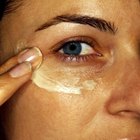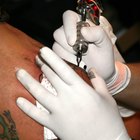
A common misconception about white tattoo ink is that the color white is the most painful ink to receive. The reason for this is that the application of white ink is the last part of the tattoo. During a tattoo, your body's endorphins aid you in coping with the pain, but at the end of a tattoo, your endorphins are usually depleted, allowing you to feel more pain during the application of the white ink.
Identification
White tattoo ink is a combination of a pigment and a carrier. Titanium dioxide, lead carbonate, anatase or rutile are all possible ingredients of white tattoo ink. The carrier solution in the white tattoo ink aids in even distribution and application of the pigment and also disinfects the pigment. Ingredients of tattoo ink are not regulated by the Food and Drug Administration, and tattoo ink suppliers are not required to list the ingredients on the bottle.
Significance
White tattoo ink is primarily used in the tattoo process as a highlight color. White tattoo ink highlights other bright colors to bring depth and light to the tattoo design. Currently, there is a growing trend of requests for all-white tattoos, but while some tattoo artists perform completely white tattoos, others refuse and will advise you not to receive a tattoo in white ink. White can yellow or turn brown over time, and covering up the yellow or brown with more white ink is not an option. Although some tattoo enthusiasts believe that an all-white ink tattoo is invisible, this is not the case. White ink tattoos are not as apparent on the skin as black and gray or full-color tattoos, but they are visible to the naked eye.
Size
Because white tattoo ink is primarily a highlight color for tattoo designs, only a small amount of white tattoo ink is used during a tattoo procedure. Two or three drops of the white tattoo ink in an ink cap is sufficient for highlighting a tattoo. White tattoo ink is available in 2 oz. and 4 oz., which will last a tattoo artist a considerable amount of time if using the white tattoo ink only for highlights on designs.
Types
Other than traditional white tattoo ink, black-light white tattoo ink is available. Applying the ink to the skin allows for a discreet tattoo. When placed underneath a UV black-light, the tattoo is radiant, white with a purple hue and highly visible. All of the other colors of UV-sensitive tattoo inks show without the black-light except for the white, which is advertised as "virtually invisible," by the manufacturer, Crazy Chameleon.
Considerations
Scarring is a side effect from receiving a tattoo in white ink. The scarring occurs from the tattoo artist overworking your skin with the needle. This is common with white tattoo ink because the ink is hard to see on fair skin and the artist adds unnecessary work. The yellowing of a white tattoo, with traditional or UV black-light ink,can cause issues in your workplace or at school if the tattoo becomes a noticeable color on a visible spot on your body, such as your hands, neck or forearm. If you are considering a completely white tattoo, choose a tattoo artist that specializes in them and look through his portfolio to see healed white tattoos.
Related Articles

How to Remove a New Tattoo

How a Tattoo Stencil Is Made

How to Remove an Eyebrow Tattoo

Why Does Ink Come Out of a Tattoo?

The Best Hair Removal Technique for ...

Pros & Cons of Spray-on Tans

The Best Facial Moisturizers for People ...

How to Make Temporary Tattoos Last ...

TCA Tattoo Removal Tips

What is the Cause of White Stretch Mark ...

How to Clean Tattoos With Rubbing ...

How to Fix the White Spots After a ...

How Can I Remove Ball-Point Ink From ...

Instructions for How to Use a Wella ...

How to Keep Your Tribal Tattoo Black

How to Get Rid of a Tattoo Scab

What Is the Difference Between Tattoo ...

Difference Between Permanent Hair Color ...

Can You Use Henna Ink As Eyeliner?

How to Make Tattoo Ink Lighter
References
Writer Bio
Maude Coffey retired after 10 years working as a professional body modification artist in the tattoo industry. She is certified in principles of infection control and blood-borne pathogens. Coffey received additional training and classes, such as anatomy, jewelry standards and aftercare, from the Association of Professional Piercers. Coffey aims to educate about safe tattooing and piercing practices while writing for various websites.
Photo Credits
tattoo image by Carlos-bcn from Fotolia.com